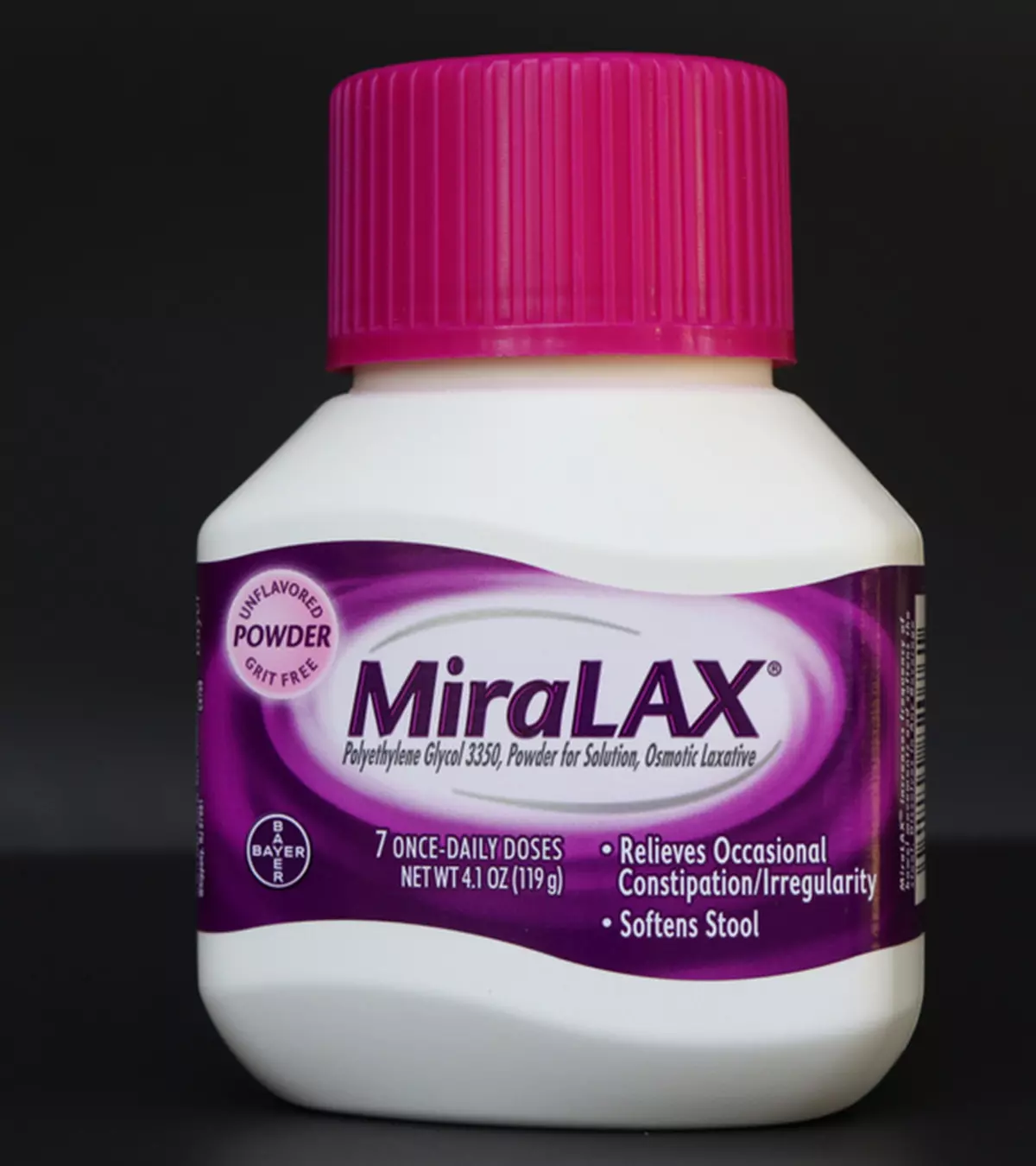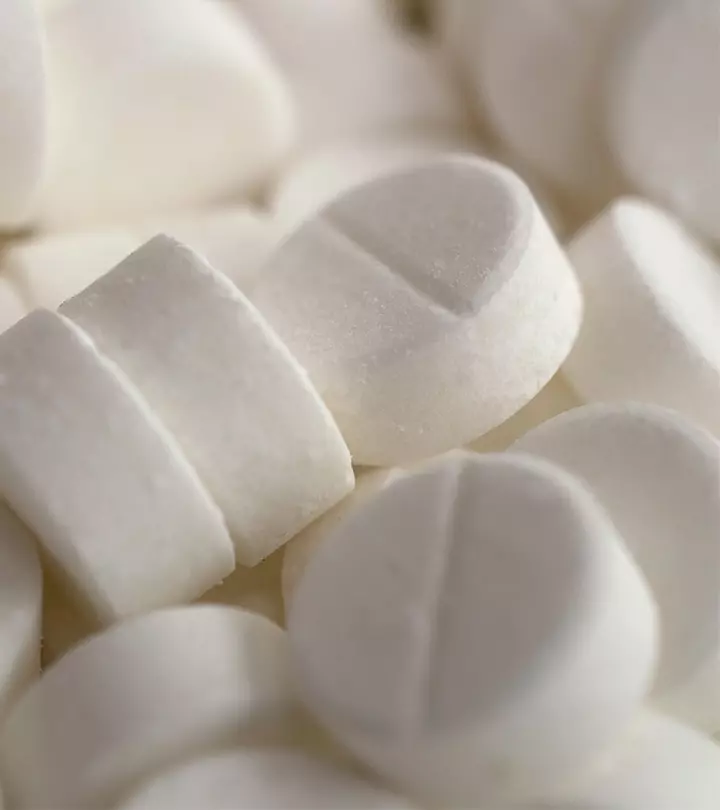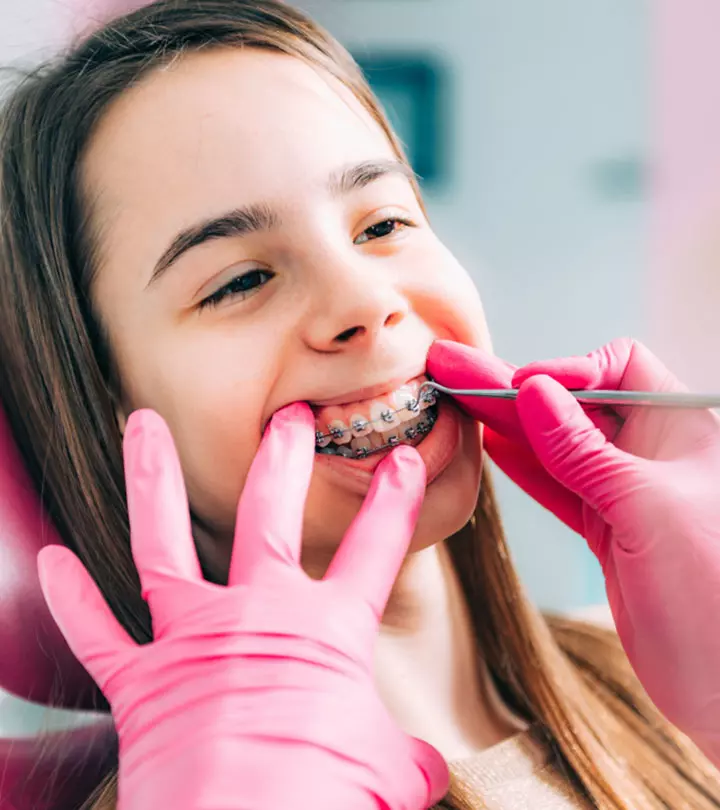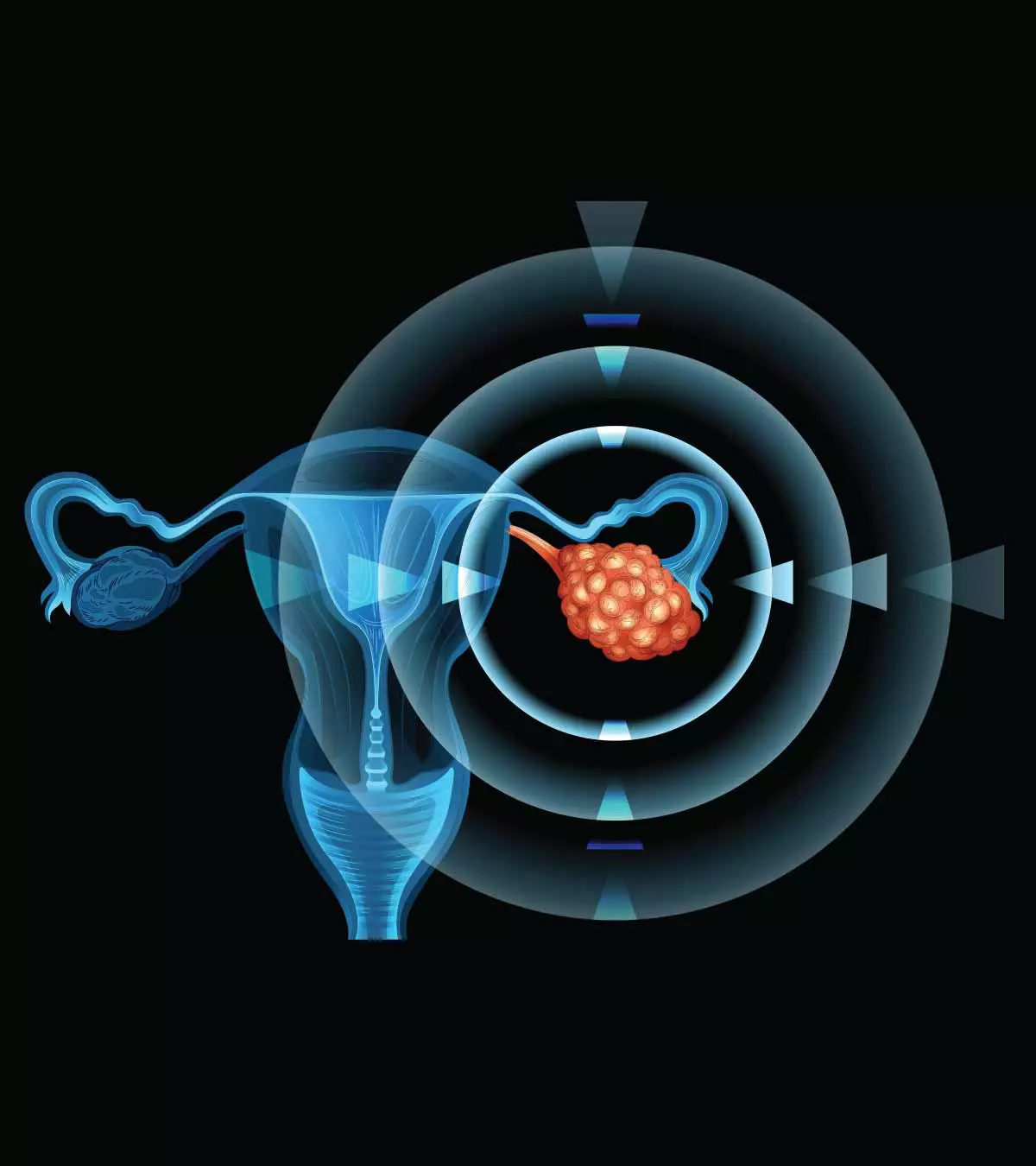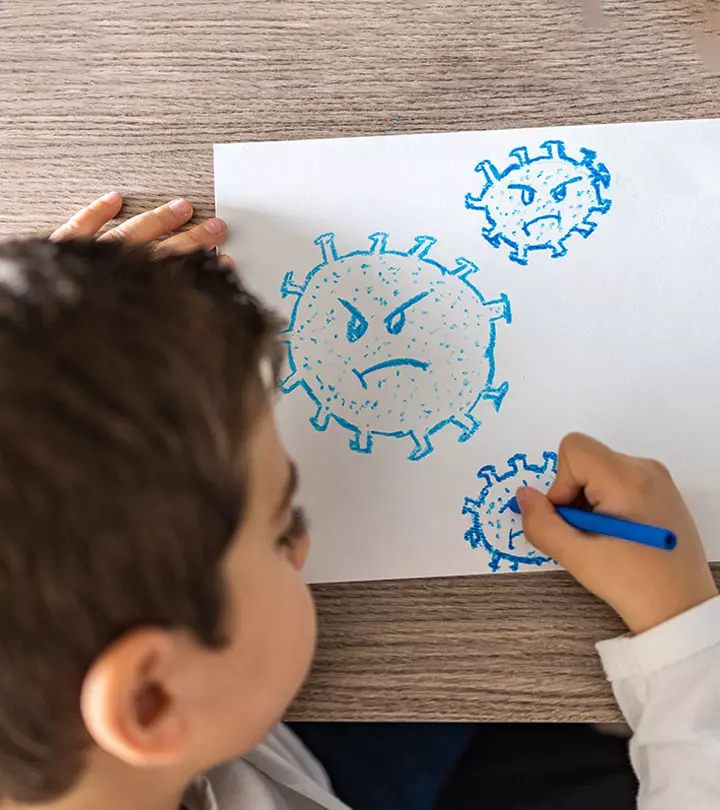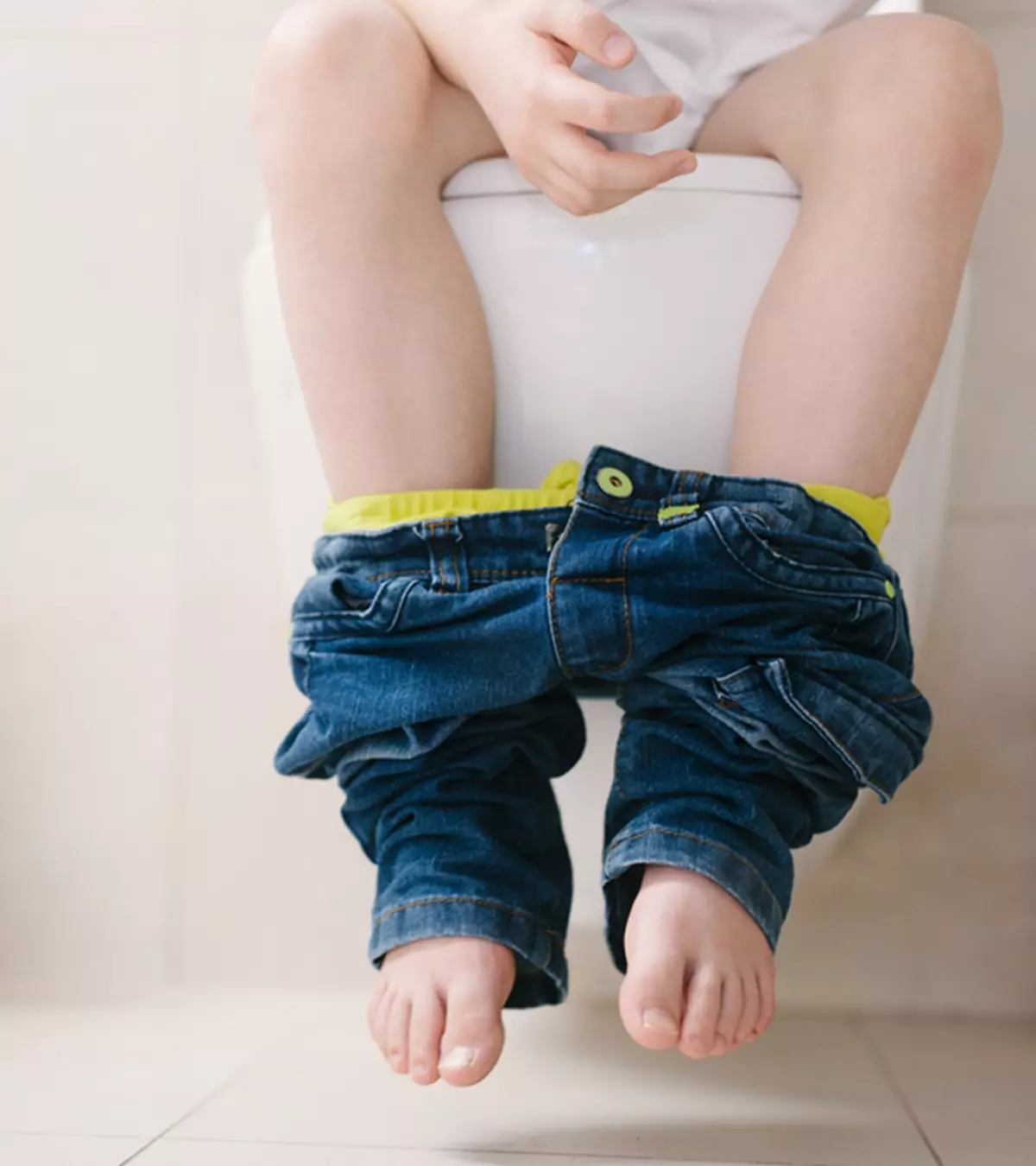
Image: ShutterStock

Noticing white or gray hair in children might cause concern in parents. The graying of hair in older adults is a natural process. But premature graying of hair in children is not. Premature graying refers to the occurrence of gray or white hair in children before the age of 20. Although the reason might be genetic in some children, it might also be associated with a health condition such as vitiligoiAn autoimmune condition that results in white patches or loss of skin color or neurofibromatosisiA rare genetic disorder that typically causes benign tumors in the skin and the nervous system . Thus, it is essential to get your child checked by a doctor if you start to notice the graying of their hair. Read on to know more about the causes and treatment options available to help with this condition.
Read on to know more about the causes and treatment options available to help with this condition.
Key Pointers
- Your hair gets its color from melanin pigment. Signs of gray or white hair arise due to a reduction in the melanin quantity.
- There are many factors responsible for premature graying of hair, including genetics, nutritional deficiency, underlying medical conditions, synthetic hair products, stress, pollution, and exposure to UV rays.
- One can prevent further graying of hair by consuming a nutritious diet, protecting hair from harmful UV rays, and maintaining a healthy sleep pattern.
- Premature graying of hair due to genetics cannot be treated.
- White hair cannot turn black naturally. One can only prevent further graying of hair.
- Massaging the scalp, consuming a nutritious diet, treating underlying medical conditions, and using antioxidants can help prevent further graying of hair.
Possible Causes Of White Or Gray Hair In Children
Hair color comes from melanin pigment. Hair begins to gray or turn white due to a reduction in the melanin quantity. It usually happens with aging, but some other reasons may cause hair to turn white in children.
- Genetics: It is one of the many factors responsible for premature graying of hair. According to a study, hair graying is inheritable, but the underlying mechanisms are elusive (1). If the parents or grandparents experienced early graying, there is a likelihood that children may also inherit this condition. Certain studies have shown that the IRF4 gene, which is linked to hair pigmentation, can also influence premature graying by 30 percent (2).
Emily Sanchez, a vlogger, experiences premature graying, which she attributes to genetics. She began noticing gray hairs at a young age and found simple ways to cover them. She says, “I started noticing gray hair when I was a freshman in high school, so I was like 14 or 15. But it was just here and there. It did always start in the front, but they were very small hairs. Sometimes I wouldn’t even notice them, and ways that I would cover them up would be with mascara. Since they were just one at a time, I would just pick the hair and use mascara to color it…But the reason why I started so young is because it’s hereditary. It’s in my genes. I got this from my dad (i).”

- Nutritional deficiency: While its direct role in melanogenesis is not well-established, some clinical cases have reported associations between B12 deficiency and depigmentation of scalp hair (3). A research study on the young Indian population associated premature hair graying with the deficiency of calcium, vitamin B12, and vitamin D3 (4). However, the exact mechanism is unknown.
 Did you know?
Did you know?- Medical conditions: Certain genetic and autoimmune disorders can interfere with melanin production, leading to early graying (6). Genetic and autoimmune conditions such as Werner’s syndromeiA rare genetic disorder indicated by the symptoms associated with aging , vitiligo in children, and thyroid disease are associated with premature hypopigmentation of hair (7).
- Synthetic hair products: Some sources suggest that the use of shampoos, dyes, and lotions containing chemicals may contribute to premature graying of hair. However, scientific studies directly linking these products to early graying are limited, and the evidence remains inconclusive.

- Exposure to smoke: While there are no scientific studies directly linking smoke exposure to gray and white hair in young children, research has shown that tobacco smoke causes nicotine build up in hair follicles and the hair shaft, leading to premature graying in adults. Hence, it is crucial to prevent children from smoke exposure to avoid these negative effects (8).
- Anemia: Iron deficiency may cause anemia, affecting melanogenesis and hair color. This condition can make children feel fatigued and cause their hair to turn white. Pernicious anemia can also result in premature graying of hair in children (9).
- Poliosis: Poliosis is characterized by the absence of melanin in hair, leading to hair graying due to a reduction in melanin. While poliosis can occur at any age, it often appears in childhood due to certain acquired and genetic conditions. Poliosis usually shows up as white hair in specific parts of the scalp. Children with poliosis may have lighter hair color, known as pigment dilution, or develop gray hair (10).
- Other factors: Some external factors such as stress, exposure to pollution and UV rays may also be responsible for gray and white hair at a young age. These external factors could cause oxidative stress leading to premature graying of hair (11).
 Research finds
Research findsThere is no single reason for the development of white hair in children. It may be a result of one factor or a combination of several factors. Spotting a white hair on your child can prompt you to look for a remedy.
Can Premature Graying Or White Hair Be Treated In Children?
There is no specific treatment for premature graying. Certain causes of white hair like faulty genes or autoimmune disorders may not have a cure. You may discuss with a pediatrician about the best course of treatment that could work for your child.
However, some measures may help control further graying of hair. For instance, having a nutritious diet and taking nutritional supplements (as prescribed by the doctor) may help the child in reducing white or gray hair.
Protection from harsh sun rays and a healthy sleep pattern may also help with graying and facilitate proper hair care.
Can White Hair Be Prevented?
If premature graying of hair is due to genetics, then it cannot be prevented. However, if it is due to a medical condition or due to diet or lifestyle changes, then you may be able to prevent white hair or worsening of it.
 Did you know?
Did you know?Tips To Prevent Premature Graying Of Hair
These measures may help children and people of a young age to prevent white or gray hair.
- According to a study, massaging with coconut oil improves blood circulation, restores hair color, and prevents graying. The report states, “Coconut oil owing to its low molecular weight and high affinity for hair proteins, having the capacity to penetrate the cuticle and displacing the air which has replaced the melanin, may have a role in not only delaying the premature greying of hair but also giving cosmetic acceptability to the hair by making them appear less grey (14).”

- Adding foods rich in vitamin B12 and calcium supply nutrition to hair follicles and may prevent further graying of hair (15).
- Treating the underlying diseases or medical conditions may stop the graying of hair.
- The use of antioxidantsiCompounds that inhibit the oxidation process and protect the cells from damage may help in the prevention of premature graying of hair (16). Some foods rich in antioxidants include berries, pomegranate, tomatoes, and pecans (17).
- According to the International Journal of PharmTech Research, Murraya koenigii or curry leaves can help in the prevention of premature graying of hair (18).
- A research study has found that Indian gooseberry prevents graying hair and also maintains its color (19).

- Bhringraj or false daisy was used in traditional therapies for the premature graying of hair (20).
- UV rays can damage hair follicles, causing gray or white hair. Almond oil, with its Vitamin E and fatty acids containing double bonds, helps protect against UV radiation (11) (21).
 Quick tip
Quick tipThe preventive methods may or may not work for all children. Moreover, some children may be sensitive to natural or herbal remedies. Speak to your child’s doctor before trying any treatment for premature graying of hair in children.
Is It Okay To Pluck White Or Gray Hair?
Here’s a myth – Plucking one gray hair will give rise to several new gray hair.
Dr. Shashank Kraleti, UAMS family and preventive medicine physician, debunks it by saying, “Plucking strands of hair may traumatize the follicle and may even cause scar formation or infection. If you want to get rid of gray hair, you need to cut it off carefully (23).”
Can White Hair Turn Black Again Permanently?
White hair cannot turn black naturally. However, lifestyle changes and a balanced diet may help further whitening or graying of hair.
Can Children Dye Their Hair?

It depends on the age of your child and the cause behind the premature graying of hair. Dyeing is usually not recommended for school-going children because the dyes are often laden with chemicals that may be more harmful to children than adults. If white hair is causing distress to the child, and they insist on dyeing, then consult a doctor, who might suggest products that are safe for the child. Prioritize your child’s health and well-being over aesthetics, and ensure that any decision made is in their best interest.
How To Help A Child Cope With White Or Gray Hair?
Helping a child cope with white or gray hair involves understanding their feelings and providing supportive guidance. Here are some steps to assist them:
- You can explain to them how anyone, regardless of age, can develop white or gray hair. Normalize their experience by letting them know it’s okay and natural.
- Encourage them to accept their own unique hair color. Emphasize the positive aspects and reassure them that their worth is not determined by the color of their hair.
- Educate them about hair pigmentation and the factors that affect changes in hair color. Understanding these aspects can help dispel fears and misunderstandings.
- Provide a secure environment where they can share any worries or uncertainties. Listen attentively and with empathy to grasp their point of view.
- Observe the child’s mood and inquire about their experiences to detect possible signs of bullying.
- If the child experiences bullying, they should be encouraged to seek support from trusted adults or safer peer groups.
- Consulting a counselor or therapist can assist the child in developing confidence and effective coping strategies.
- If necessary, seek advice from a dermatologist or pediatrician for additional support and to assess any potential medical issues.
White or gray hair in children could result from various genetic, nutritional, and environmental factors. Although most underlying causes may not be preventable, this condition is seldom a cause for concern and usually doesn’t harm a child’s overall health. However, if you are concerned about premature graying of hair in your child, speak to a doctor to comprehend the reasons and possible remedies or treatments. Also, ensure that you offer ample emotional support to your child to avoid the unfavorable effects of this condition on their mental health.
Frequently Asked Questions
1. How does premature graying in children differ from that in adults?
Premature graying in children differs from that in adults because of its causes and psychological effects. Children may experience premature graying due to genetics, nutritional deficiencies, autoimmune disorders, or environmental factors. Unlike adults, where aging plays a major role, premature graying in children can occur abruptly and unexpectedly (9).
2. Are there hereditary factors that may increase the possibility of a child having white or gray hair?
The primary risk factor of premature gray hair is considered to be genetic (4). Studies have found one gene, IRF4, to be associated with hair graying. The gene is responsible for synthesizing the pigment melanin (24).
3. Are there any psychological effects of white or gray hair in children?
Premature gray hair in children may adversely affect their self-esteem (11).
4. Are there any long-term risks associated with white or gray hair in children?
Premature graying of hair may be associated with long-term underlying health conditions such as thyroid disorders, metabolic disorders, oxidative stress, and nutritional deficiencies (vitamins B12 and D deficiency). It may also be linked to aging disorders (progeria and pangeria), atopic diathesis (asthma, allergic and atopic dermatitis), and autoimmune diseases (11).
5. Can sun exposure influence the appearance of white or gray hair in children?
UV radiation from the sun is known to cause oxidative damage to hair follicles, which can contribute to premature graying of hair in adults. While there’s little research on how sun exposure affects children’s hair color, protecting them from too much sun might help delay or lessen this effect (11).
6. Can hormonal imbalances cause white or gray hair in children?
Hormonal imbalances can lead to white or gray hair in children. Melanin production, crucial for hair color, is influenced by hormones. Hormonal disruptions, including those associated with thyroid disorders, can impact melanin synthesis. Thyroid hormones T3 and T4 directly affect hair follicles to stimulate melanogenesis. Reduced levels of these hormones have been linked to premature graying of hair (9) (11).
7. At what age can someone start getting white hair?
Board-certified dermatologist Dr. Yoram Harth from the San Francisco Bay Area explains, “The youngest age to get white hair can vary, but it can occur in childhood or early adolescence. Cases of children as young as ten developing white hair have been reported, often due to genetic predisposition, vitamin and mineral deficiencies, or underlying medical conditions.”
8. What should I do if my child is bullied for their gray hair?
It is vital to address the situation promptly. Speak with teachers or school counselors to ensure a supportive environment, and encourage your child to reach out to trusted adults.
Infographic: Which Micronutrient Deficiencies Can Cause Premature Graying Of Hair?
Hair health depends on the nutritional status of the child. Although heredity may influence premature hair graying, it is unlikely to happen in children. Go through the infographic to learn common micronutrient deficiencies leading to premature graying of the hair in children.
Some thing wrong with infographic shortcode. please verify shortcode syntax
Illustration: Premature Graying Or White Hair In Kids: Causes & Prevention

Image: Stable Diffusion/MomJunction Design Team
It is not a common occurrence for kids to have white hair and if your child is one of the few you may wonder why this is happening. Check out this informative video exploring the potential causes of this phenomenon and also providing helpful advice.
Personal Experience: Source
MomJunction articles include first-hand experiences to provide you with better insights through real-life narratives. Here are the sources of personal accounts referenced in this article.
i. Gray hair and how to cover it, before and after extreme hair transformation.
https://youtu.be/GF6v7TxuXw4?feature=shared
References
- Y. Bian et.al; (2019); Global downregulation of pigmentation-associated genes in human premature hair graying.
https://pdfs.semanticscholar.org/0110/de90a7deb142ca9ea1e8daf48f12814e6c96.pdf - Burçin Aktaş and Oytun Erbaş; (2025); Interferon Regulatory Factors 4 (IRF4) Gene and Hair Graying.
https://jebms.org/full-text/51#:~:text=Although%20all%20the%20factors%20affectingwas%2030%25%2C%20was%20determined - Zuzanna Rzepka et.al; (2018); Vitamin B12 Deficiency Induces Imbalance in Melanocytes Homeostasis—A Cellular Basis of Hypocobalaminemia Pigmentary Manifestations.
https://pmc.ncbi.nlm.nih.gov/articles/PMC6163934/ - S. Chakrabarty et.al; (2016); Factors Associated with Premature Hair Graying in a Young Indian Population.
https://www.ncbi.nlm.nih.gov/pmc/articles/PMC4830165/ - Deepashree Daulatabad et.al; (2017); Prospective Analytical Controlled Study Evaluating Serum Biotin Vitamin B12 and Folic Acid in Patients with Premature Canities.
https://www.ncbi.nlm.nih.gov/pmc/articles/PMC5514791/ - Yuji Yamaguchi and Vincent J Hearing; (2014); Melanocytes and Their Diseases.
https://pmc.ncbi.nlm.nih.gov/articles/PMC3996377/ - C. Black; (2015); Familial aggregation of phenotypic expression of premature hair hypopigmentation in the craniofacial region.
https://dentistry3000.pitt.edu/ojs/index.php/dentistry3000/article/view/31 - Babadjouni Arash et.al; (2025); The Effects of Smoking on Hair Health: A Systematic Review.
https://karger.com/sad/article-pdf/7/4/251/3531060/000512865.pdf - Mahajan None Suresh et.al; (2025); Review on Premature White and Grey Hair in Children.
https://www.researchgate.net/publication/350657932_Review_on_premature_white_and_grey_hair_in_children - Rangu Sneha A. and Vikash S. Oza; (2025); Poliosis Hair Pigment Dilution and Premature Graying of the Hair: A Diagnostic Approach in Pediatric Patients and Review of the Literature.
https://onlinelibrary.wiley.com/doi/abs/10.1111/pde.15498#:~:text=Poliosis%20is%20defined%20as%20theevaluation%20from%20a%20pediatric%20dermatologist - A. B. Kumar et.al; (2018); Premature Graying of Hair: Review with Updates.
https://www.ncbi.nlm.nih.gov/pmc/articles/PMC6290285/ - How Stress Causes Gray Hair.
https://www.nih.gov/news-events/nih-research-matters/how-stress-causes-gray-hair - Burçin Aktaş and Oytun Erbaş; (2025); Interferon Regulatory Factors 4 (IRF4) Gene and Hair Graying.
https://www.researchgate.net/publication/355039063_Interferon_Regulatory_Factors_4_IRF4_Gene_and_Hair_Graying - R. Mahajan et.al; (2018); Premature Graying of Hair and Role of Oiling in Indian Perspective.
https://ijcrims.com/pdfcopy/feb2018/ijcrims15.pdf - Bhat Ramesh M et.al; (2013); Epidemiological and Investigative Study of Premature Graying of Hair in Higher Secondary and Pre-University School Children.
https://journals.lww.com/ijot/fulltext/2013/05010/epidemiological_and_investigative_study_of.5.aspx - Ying Shi et.al (2014); Premature Graying as a Consequence of Compromised Antioxidant Activity in Hair Bulb Melanocytes and Their Precursors.
https://pmc.ncbi.nlm.nih.gov/articles/PMC3973559/ - Monica H Carlsen et.al; (2010); The total antioxidant content of more than 3100 foods beverages spices herbs and supplements used worldwide.
https://pmc.ncbi.nlm.nih.gov/articles/PMC2841576/ - M. Nishan and P. Subramanian; (2014-2015); Murraya koenigii (curry leave) – A review on its potential.
https://www.sphinxsai.com/2015/ph_vol7_no4/1/(566-572)V7N4.pdf - H. S. Grover et.al; (2015); Therapeutic effects of amla in medicine and dentistry: A review.
https://www.researchgate.net/publication/287972436_Therapeutic_effects_of_amla_in_medicine_and_dentistry_A_review#:~:text=Amla%20is%20useful%20in%20ulcer - R. Jahan et.al; (2014); Ethnopharmacological Significance of Eclipta alba (L.) Hassk. (Asteraceae).
https://www.ncbi.nlm.nih.gov/pmc/articles/PMC4897414/ - Arghya Arpita and Venkataram Mysore; (2025); Hair Oils: Indigenous Knowledge Revisited.
https://www.ncbi.nlm.nih.gov/pmc/articles/PMC9231528/ - Farahnaz Fatemi Naieni et.al; (2012); Serum iron zinc and copper concentration in premature graying of hair; NCBI
https://pubmed.ncbi.nlm.nih.gov/21979243/ - Does Pulling One Gray Hair Cause More to Grow in its Place?
https://uamshealth.com/medical-myths/does-pulling-one-gray-hair-cause-more-to-grow-in-its-place/#:~:text=those%20gray%20hairs%3F- - Ewelina Pośpiech et.al; (2025); Exploring the possibility of predicting human head hair greying from DNA using whole-exome and targeted NGS data.
https://bmcgenomics.biomedcentral.com/articles/10.1186/s12864-020-06926-y
Community Experiences
Join the conversation and become a part of our nurturing community! Share your stories, experiences, and insights to connect with fellow parents.
Read full bio of Dr. Anuradha Bansal
- Dr. Yoram Harth is a board-certified dermatologist and a member of the American Academy of Dermatology (AAD). He is a former research fellow at the Department of Dermatology Columbia Presbyterian in New York, author of several scientific publications, and winner of the Wall Street Journal Europe award for innovations in Aesthetic and Medical Dermatology.
 Dr. Yoram Harth is a board-certified dermatologist and a member of the American Academy of Dermatology (AAD). He is a former research fellow at the Department of Dermatology Columbia Presbyterian in New York, author of several scientific publications, and winner of the Wall Street Journal Europe award for innovations in Aesthetic and Medical Dermatology.
Dr. Yoram Harth is a board-certified dermatologist and a member of the American Academy of Dermatology (AAD). He is a former research fellow at the Department of Dermatology Columbia Presbyterian in New York, author of several scientific publications, and winner of the Wall Street Journal Europe award for innovations in Aesthetic and Medical Dermatology.
Read full bio of Dr Bisny T. Joseph
Read full bio of Swati Patwal
Read full bio of Anindita Ghatak







